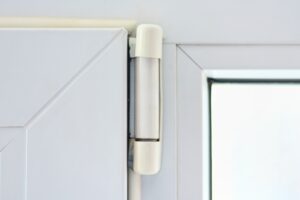How To Adjust uPVC Door Hinges [5 Method Guide]
Can uPVC door hinges be adjusted?
Have you noticed that your uPVC door has started to rub against the floor, is letting a draught into your property or isn’t set at the correct height? Well, if your uPVC door is causing you issues, it may not be a case of having to repair it or buying a completely new one; instead, it may be a case of simply tweaking the hinges so that the door opens and closes as it should.
uPVC doors are made by encasing an insulated steel frame in an un-plasticized polyvinyl chloride (uPVC) to create a securely sealed unit which is strong and thermally efficient for your home. uPVC doors are an affordable and effective option for your home that is fully customisable and stylish in design. They are durable and long-lasting with a lifespan of up to 35 years however sometimes they can cause you issues through the daily wear and tear.
Throughout the years of usage, it is common for your uPVC door to become out of shape and hinges to become loose. This is why you may notice after a few years your uPVC door starts to drag along the floor of your home or has begun letting in a draught. With that being said, there are some simple tweaks that we will explore in this article which should resolve the problem you are facing.
As the leading uPVC door provider in Cardiff, here at Captial UPVC, we are a window specialist that can install many different types of fantastic windows across the Cardiff area including uPVC doors that offer a stunning addition to your property. Through our years of experience with uPVC doors, we often get five common questions about uPVC doors.
Throughout this article, we will explore the five different methods by which you can adjust your uPVC door so it works efficiently and securely.
What are the different types of hinges on a uPVC door?
As there are different types of uPVC doors, you may come to find that your door has a different style of hinge. The most common hinge types found on uPVC doors include flag hinges, T hinges and Butt hinges.
A flag hinge is typically found on modern uPVC doors and is a style of hinge that allows you the most control over making adjustments to your uPVC door. Their appearance is similar to a flag shape allowing the door to be adjusted laterally, vertically and be compressed too.
A T hinge is similar in functionality to a flag hing however can only provide movement laterally and vertically and can therefore not be compressed. The hinge is shaped like the letter “T” and is easily identifiable.
Butt hinges are the oldest style of hinge found on uPVC doors however are still commonly found in homes up and down the country. Depending on the age of the butt hinge you may be able to adjust laterally and vertically or not be able to adjust the door at all. It is a gamble that you will have to check out if you own a uPVC door with a butt hinge.
5 ways you can adjust your uPVC door hinges
Throughout this article, we will explore five of the most common questions we get asked about uPVC hinges as the leading uPVC door provider in Cardiff and the South Wales area.
The five different hinge problems we will cover include:
- How to adjust the height of your uPVC door
- How to stop draughts
- How to stop your uPVC door from dragging
- How to adjust the door hinge from side to side
- How to adjust the compression of your door
How to adjust the height of your uPVC door
If you have noticed that your uPVC door is too tall or too short in height and needs to be adjusted to your property’s requirements you can fix this issue by simply levelling the height of the door.
Firstly, check the alignment of the door and ensure it is levelled. If the door is not levelled, you need to adjust the hinges so that it is. From here, once you have ensured your door is level, check the seal around the edge of the door. If there are any gaps in the seal, fill them with sealant.
Once you have done this, check the door is level again. Once you have confirmed the level of your door, the height should be even. If the door is still uneven in height, it may be time to think about replacing it. If you live in Cardiff, here at Capital UPVC we stock a huge selection of doors that you can be effortlessly installed into your home. Call us on 029 2047 2700 today.
How to stop draughts
uPVC doors are designed to keep your home energy efficient and stop draughts from entering. However sometimes with older uPVC doors, the alignment and hinges become loose allowing draughts from outside to enter your home.
To fix this issue, locate the Allen key spot in the door hinge. From here, insert the key and twist it to the right to adjust the door hinge. The door should move back towards the door frame.
Continue doing this for all hinges until there are no gaps for draughts to enter the property. From here level out the door and ensure it is balanced properly. Once this is complete do a quick spot check of the weather stripping on the door. If this is damaged it may also be a cause of letting a draught into your home. If you notice that it is damaged you will need to replace it.
How to stop your uPVC door from dragging
If your uPVC door is dragging on the floor it can be an annoying inconvenience that can lead to damage to your property flooring which can not only be a time-consuming mess but also extra costs to repair.
To amend this problem, grab an Allen key and adjust the screw on the side of the door hinge. From here, rotate the screws to the right to see if the door still drags. Be careful as you do not want to adjust the screw the entire way and is more of a loosening process until the door starts to move smoothly without touching the floor when opening and closing.
Make sure to keep testing the door a few times to ensure that it opens and closes smoothly. If you notice that it is making a creaking noise you will need to tighten the screws because it means the door is not securely adjusted.
How to adjust the door hinge from side to side
If you notice that your door is unaligned from a sideways standpoint, you will need to adjust it.
To do this, simply remove the side cover hinge caps and rotate the adjustment drives from the left to the right to tighten the hinges and from right to left to loosen the hinges. It is advised that you adjust gradually on both sides of the door until you achieve the desired adjustment.
How to adjust the compression of your door
If your door starts to get separated from the frame, you can fix this issue by tightening the door hinges.
In order to fix this, identify the screw on the hinge which will allow you to adjust the compression of your door. The location of this screw will differ from the three different types of hinges found on uPVC doors.
Using an Allen key simply tighten the compression screw so that the door comes closer aligned to the frame leaving no gaps. This will adjust the compression of the door and allow your door to not have a large gap between the hinges and the door itself.
Conclusion
As uPVC door providers, we tried to cover five of the most common questions we get asked when it comes to adjusting your uPVC door hinges so that they don’t cause issues in your property. From uPVC doors that drag on the ground to those that let draughts in, hopefully, this guide has provided you with a comprehensive breakdown of different ways you can amend the issue by simply adjusting the hinges on your door.
Therefore, you will not have to fear spending more money on a new one or getting an expert to come and repair your uPVC door. That being said, if you do attempt to adjust the hinges on your uPVC door and notice that it has not fixed the issue, it may be time to replace the door completely.
Fortunately, if you live in the Cardiff and South Wales area, here at Capital UPVC, we provide a selection of uPVC doors in a range of colours and designs. All of our doors are guaranteed to provide security and energy efficiency for your home. We also provide fabulous finance options too. Get a quote online today or speak to a member of the team on 029 2047 2700.
Recent Posts
Archives
- March 2024
- February 2024
- January 2024
- December 2023
- November 2023
- September 2023
- November 2020
- October 2020
- September 2020
- August 2020
- July 2020
- June 2020
- May 2020
- March 2020
- February 2020
- January 2020
- December 2019
- November 2019
- October 2019
- September 2019
- November 2018
- October 2018
- July 2018
- June 2018
- March 2018
- January 2018
- December 2017
- March 2017



Recent Comments